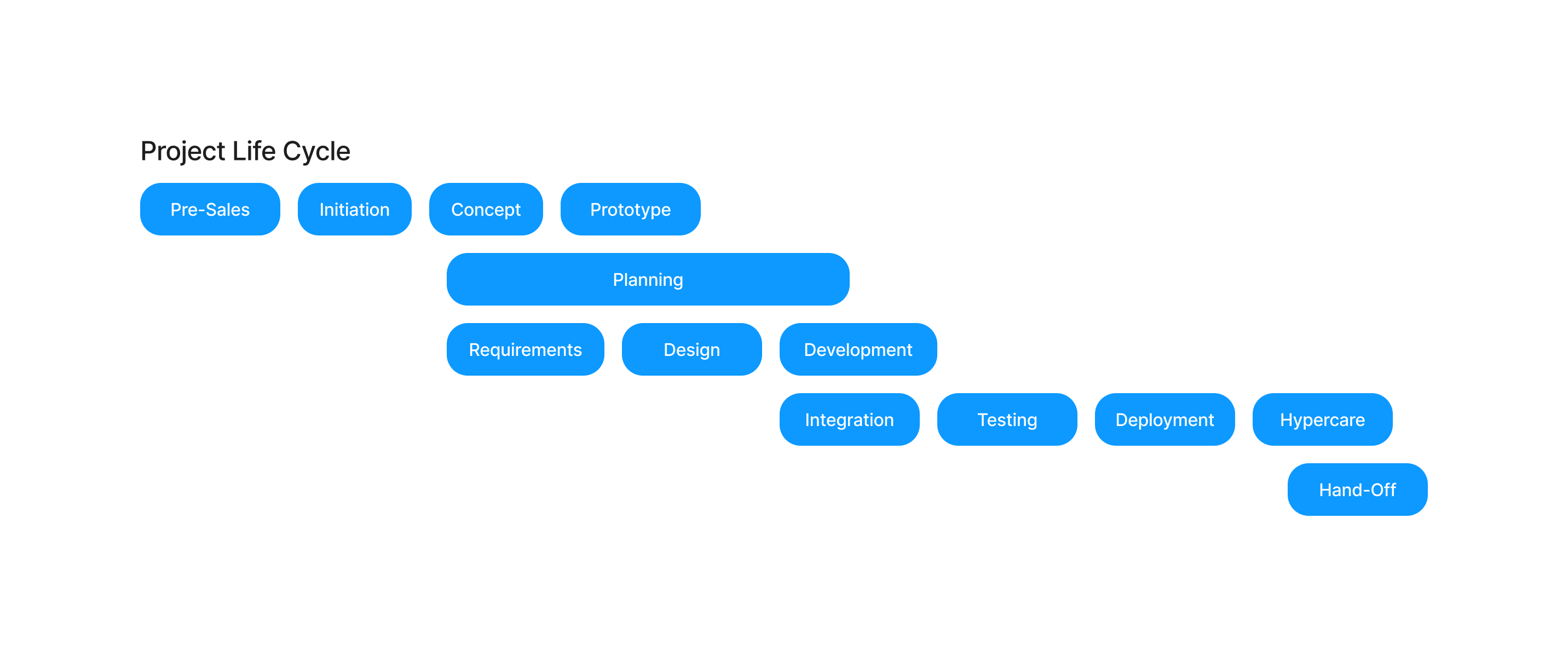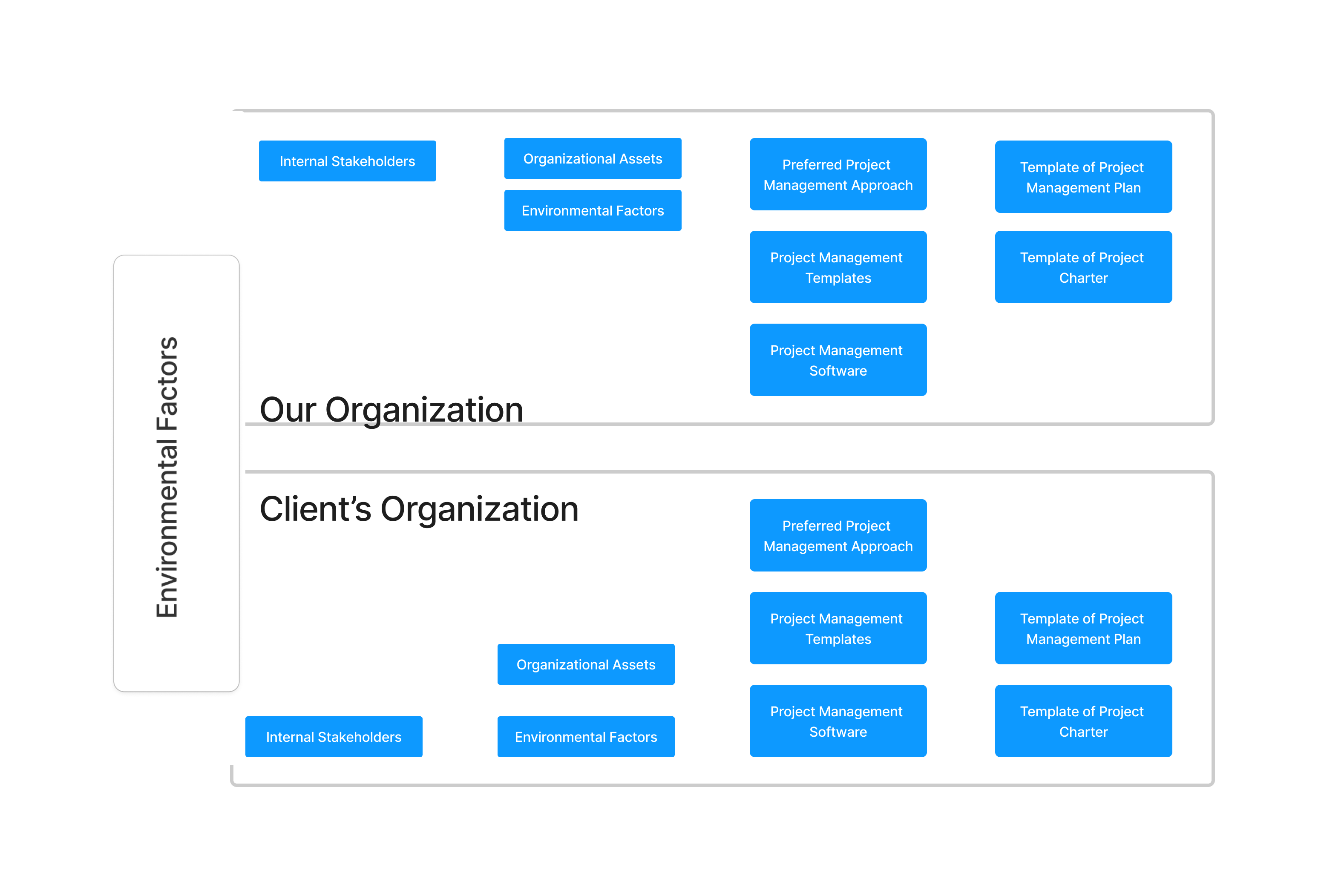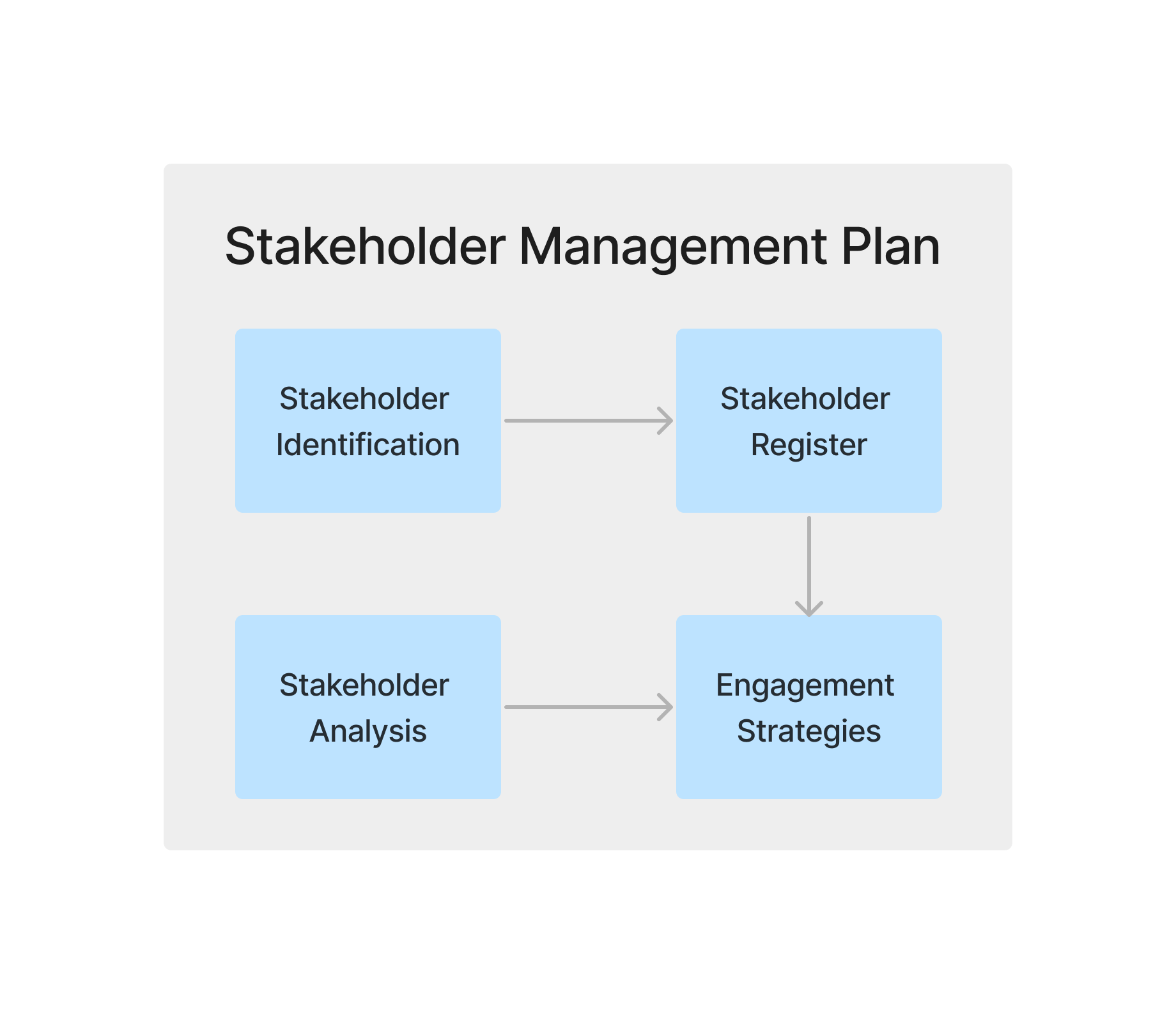What is a project?
A project is a time-limited endeavor aimed at creating a unique product, service, or result. It involves a specific goal and requires the application of various skills, knowledge, and tools.
Understanding Project Management
Project management is the discipline that encompasses the practices and techniques used to increase the likelihood of a project’s success in achieving its intended business objective.

Table of Contents
Project Life Cycle


Projects within an organization are significantly influenced by the environment in which they operate. Two key factors that impact project management are organizational assets and environmental factors.
Organizational assets consist of the resources and tools available within the performing organization. These assets include lessons learned from previous projects, guidelines, templates, workflows/processes, historic records, accounting practices, and project management software. They provide valuable insights, guidance, and support for managing projects effectively.
On the other hand, environmental factors are external influences that are beyond the control of the project team. These factors include the skills of human resources available, industry standards and regulations, organization culture, organization structure, political conditions, and the availability of resources. These factors shape the context in which the project operates and can impact project success.

While project managers must consider and navigate these organizational assets and environmental factors, there is no one-size-fits-all approach to project management. Each project requires a tailored approach based on its unique characteristics and the specific needs of the stakeholders involved.
When working in a client-vendor relationship, project managers must consider the requirements and expectations of both organizations. This involves finding common ground in terms of project life cycle, tools, roles, and responsibilities. The environment should support the project manager in reducing the stress of organizing every aspect of the workplace for the team, allowing the manager to focus on project management and navigate the challenges with ease.
The environment can provide several benefits to project managers and their teams. These benefits may include office space, a dedicated recruitment department to acquire suitable resources, templates for consistent project documentation, project management software for efficient planning and tracking, lessons learned from previous projects, industry experiences in the form of best practices, and subject matter experts (SMEs) who possess specialized knowledge and skills.
Identifying Stakeholders

Product owners, team members, and other stakeholders are directly impacted by the project and stand to gain or lose depending on its success. The Stakeholder Register is a valuable tool that helps the project manager identify and document all relevant stakeholders. After compiling this register, the project manager conducts stakeholder analysis to understand the level of influence, interest, and potential impact each stakeholder has on the project. This analysis helps the project manager determine how to effectively interact and engage with each stakeholder throughout the project lifecycle.
Stakeholders play a crucial role in providing requirements for the product or service being developed. They may also have expectations regarding the project management approach, specifying the methodologies or tools they want the project manager to utilize in their environment. It is the responsibility of the project manager to collect and consolidate requirements from all project stakeholders. This process is critical as misidentifying or overlooking important requirements can lead to project failures or dissatisfaction among stakeholders.
During the course of a project, unexpected events or changes may occur that deviate from the original plan. In such cases, the project manager needs to explain to stakeholders why certain things may not happen as anticipated. It is important for the project manager to clearly communicate the risks involved and the potential impacts on the project. If stakeholders insist on adding extra scope of work, the project manager must address the issue diplomatically, considering the project’s overall goals, timeline, and budget. Maintaining continuous relationships with stakeholders and being proactive in identifying any external stakeholders that may impact the project is a key responsibility of the project manager.

Pre-Sales Phase

Before a project moves into the project management phase, it is crucial for the sales team and the client to develop realistic terms and conditions. As a project manager, you can play a significant role in assisting the sales team during this process. Your involvement can help ensure that the terms and conditions agreed upon are feasible and align with the project’s objectives.
During the pre-sales phase, high-level planning, including estimating project duration and budget, becomes necessary. Being involved in the pre-sales phase is advantageous for a project manager. However, if that’s not the case, it becomes crucial for the project manager to have access to the notes, emails, and agreements made during that stage. Understanding the agreed-upon terms and conditions is important for effective project management.
When it comes to contracts, there are different types that a project manager should be aware of. A fixed-price contract is one where the payment amount does not depend on the resources used or time expended. This type of contract imposes a budget constraint. On the other hand, a time and materials contract involves being paid for the actual labor, efforts, and materials used, usually on an hourly basis. This type of contract imposes an agreement constraint.
Once the terms and conditions are negotiated and finalized, the project can officially commence based on the agreed-upon framework. The project manager then takes charge of executing the project while adhering to the established terms and conditions.
Risk Management

Project Initiation
During the Project Initiation phase, the project manager transitions from the pre-sales phase to project management. In this phase, the manager must identify three key elements: the business objective, desired results, and project boundaries. The project charter, which provides high-level information about the project, is an essential document before the planning process begins. It can be created using various mediums such as Word documents, emails, or project management tools.The project charter includes important elements such as
- Project description
- Business case
- Project objectives
- Preassigned resources
- Stakeholders
- Known requirements
- Description of deliverables
- Assumptions
- Constraints
- Project risks.
While not comprehensive, the project charter typically spans around five pages.
The collection of information during this phase aims to establish a common understanding of the project and control client expectations. It also helps determine the feasibility of developing the project’s scope. It is crucial to question anything that is not aligned with the project goal or business objective. Once the project charter is signed off, the project manager takes a broader look at the project, including the charter, contract, clients, tools, processes, and templates available. Based on the project’s lifecycle, the project manager decides on the appropriate project management approach and frameworks to use. It is recommended to follow existing PM approaches and best practices within the organization, making minor iterations as necessary to meet the clients’ needs.
Project Planning
After completing the project charter, the project manager proceeds to develop the Project Management Plan, which is considered the most important phase. This plan helps identify weaknesses, determine the project management approach and knowledge required, and systemize the project process.
The Project Management Plan encompasses various management plans, such as
- Integration Management Plan
- Scope Management Plan
- Cost Management Plan
- Schedule Management Plan
- Quality Management Plan
- Risk Management Plan
- Stakeholder Management Plan
- Communication Management Plan
- Procurement Management Plan
- Resource Management Plan
While these plans may not be explicitly written, the project manager should have a solid understanding of them to ensure a smooth project execution and to align stakeholders throughout the process. It is important to consider how all these plans interact with each other during the planning process.
During Project Planning, the project manager follows the selected project management approach.
Two fundamental principles guide the planning process:
Integration Principle #1 emphasizes planning the project in a way that aligns with the project objective stated in the charter.
Integration Principle #2 emphasizes focusing on specifying and delving deeper into the high-level information provided in the charter. By adhering to these principles, the project manager ensures that the project planning aligns with the overall project goals and objectives.
These two integration principles help the project manager stay focused on the primary objective of the business and keep the project on track. By adhering to these principles, the manager ensures that resources are not wasted on activities that do not align with the project’s goals and objectives. It also helps in managing the project within the defined constraints and boundaries.
In cases where clients want to adjust project objectives, it is important to assess the impact on the project charter. If the project charter needs to be altered, it may require renegotiating the budget, timeline, and any time and materials agreements. The project charter serves as a high-level requirement gathering document, and from there, the project manager dives deeper to form the project scope. This involves activities such as defining user stories, creating mockups, and developing wireframes to provide a clear understanding of the desired end product or solution.
Requirements for a project can be hierarchical. It starts with business requirements, which are gathered from stakeholders and subject matter experts (SMEs) from the client organization. These requirements are then communicated to specialists within the project manager’s own organization to develop solution requirements and system requirements. This can be in the form of user stories or detailed specifications that outline how to create the specific product or solution.


The rolling wave planning technique is often employed in industries where products or solutions are initiated before the complete set of requirements is known. It is an agile methodology that differs from the traditional waterfall approach. With rolling wave planning, the project manager focuses on planning for the immediate requirements in detail while keeping the requirements needed at a later date at a higher-level. This includes aspects such as scope, budget, time, and resources.
This technique is employed because, over the course of a long-duration project, requirements and negotiations can evolve and change. By adopting a rolling wave planning approach, the project manager can adapt to these changes and make more informed decisions based on the evolving information. It allows for flexibility and reduces the time spent on detailed planning upfront, as the project team can gather more information and refine the requirements as the project progresses.
The rolling wave planning technique allows for a more iterative and adaptive approach to project management. It recognizes that requirements may change over time and focuses on delivering value in increments rather than attempting to define all requirements at the project’s outset. This approach can be particularly effective in complex and dynamic projects where the full scope and requirements may be difficult to determine initially.
By embracing rolling wave planning, project managers can effectively manage uncertainty and adapt to changing circumstances while still maintaining control over the project’s direction. It allows for greater agility and responsiveness, enabling the project team to make more informed decisions based on real-time information and stakeholder feedback.

Transitioning from abstract requirements to tangible results is a critical task for a project manager. The tangible results or components of the project that are created become the project deliverables. However, there is no simple or one-size-fits-all approach to achieving this transition. It involves a combination of industry standards and the manager’s decision-making based on the specific project requirements.
On one hand, industry standards and best practices can provide guidance on common deliverables within a particular domain. These standards help establish a baseline for the expected outcomes of a project. On the other hand, the project manager must assess and determine which specific deliverables should be included in the project based on the defined requirements. This requires a thorough understanding of the project objectives, client expectations, and the overall project scope.
A traceability matrix can be a useful tool in mapping the specific deliverables to the requirements. It helps ensure that all the required deliverables are identified, tracked, and traced back to their respective requirements. This matrix serves as a reference to validate that the project is on track in terms of delivering the agreed-upon outcomes.
The project scope statement plays a vital role in communicating the deliverables to the client. It provides a narrative description of the product or project scope, explaining what the client will receive as a result of the project. The statement should clearly outline the expected deliverables, along with the estimated time and effort required to complete them. It is important to ensure that the client fully understands and agrees to the deliverables outlined in the scope statement, and the statement should be signed by the client as a formal agreement.
Once the deliverables have been agreed upon and signed off by the client, they become the basis for creating the work breakdown structure (WBS). The WBS breaks down the project scope into manageable tasks or work packages. Each work package represents a specific deliverable that the project team needs to create. The WBS helps provide a structured approach to project execution, ensuring that all the necessary tasks and deliverables are identified, assigned, and tracked throughout the project lifecycle.

By effectively managing the transition from abstract requirements to tangible deliverables, the project manager ensures clarity, alignment, and client satisfaction. It helps establish a clear understanding of what will be accomplished, sets expectations, and guides the project team in their work towards successfully delivering the desired outcomes.
Project management software plays a crucial role in supporting various project management activities. One such activity is decomposition, which involves breaking down a large, complex project into smaller, more manageable parts. Project management software often provides tools and features that facilitate this decomposition process. It allows project managers to create tasks, subtasks, and work packages, thereby breaking down the project into smaller components.
By using decomposition techniques, project managers can effectively organize and structure the project work. They can assign resources, set deadlines, and track progress at the task level. This approach enables better control and monitoring of the project, as well as improved coordination among team members.



Risk Response Plan:
Project Execution
Project baselines serve as benchmarks against which the project’s progress is measured. These baselines include the project’s cost baseline, schedule baseline, scope baseline, and quality baseline. Throughout project execution, actual values are collected and compared to the baselines to assess the project’s performance. Various formulas and calculations, such as cost variance, schedule variance, scope variance, quality variance, risk variance, and HR variance, can be used to determine the variances between the baselines and the actual values. These variances help project managers identify deviations from the initial plan and take corrective actions as needed. Change requests may also arise based on these variances.
During project execution, project managers play a crucial role in ensuring the project progresses according to the project management plan. They address technical problems, resolve conflicts, motivate team members, facilitate interactions between resources, stakeholders, and subject matter experts, and track progress. Effective communication is essential, as it accounts for a significant portion of a project manager’s time. Daily project routines, such as maintaining project information, syncing up with the project team and project owners (clients), conducting motivation routines, and managing communication, help keep the project on track and ensure that important updates and information are shared among stakeholders.
In addition to daily routines, project managers need to plan and conduct meetings as needed, following a batch approach to streamline communication and decision-making. Rolling wave planning, an agile technique, is continuously performed throughout project execution to adapt to changing requirements and uncertainties. This iterative planning approach allows project managers to focus on immediate requirements while keeping an eye on the overall project objectives.
Overall, project execution requires project managers to actively manage risks, maintain project baselines, communicate effectively, resolve conflicts, motivate team members, and continuously plan and adapt to ensure successful project delivery.







